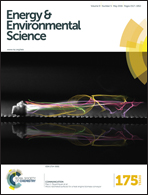Chemically exfoliated transition metal dichalcogenide nanosheet-based wearable thermoelectric generators†
Abstract
To utilize human heat energy as a permanent power source, we demonstrate, for the first time, an intrinsically highly foldable and stretchable thermoelectric generator that is based upon chemically exfoliated 1T-transition metal dichalcogenide (TMDC) nanosheets (NSs) for self-powered wearable electronics. The power factors of WS2 (n-type) and NbSe2 (p-type) NS films were evaluated to be 5–7 μ K−2 m−1 and 26–34 μW K−2 m−1, respectively, near room temperature. With these films, parallel-connected thermoelectric generators that were fabricated were able to constantly produce up to 38 nW of output power at Δ60 K. The thermoelectric device stably sustained its performance, even after 100 bending cycles and after 100 stretching cycles (50% strain). By direct observation, we found that the film is highly stretched by partial tearing and folding but still maintains an electrical percolation pathway. The morphology then is quickly recovered by a plug-in contact between the torn parts as the external strain is released. Finally, we demonstrate the electric power generation from a prototype wearable thermoelectric generator that was woven into a wristband fitted on a real human body.


 Please wait while we load your content...
Please wait while we load your content...